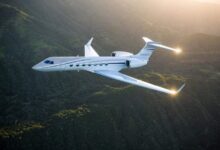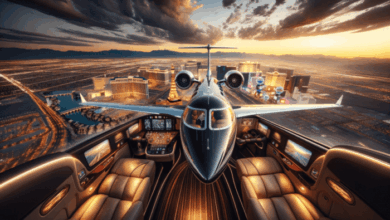The Evolution Of Private Jet Design
The Evolution of Private Jet Design sets the stage for this enthralling narrative, offering readers a glimpse into a story that is rich in detail and brimming with originality from the outset. From their humble beginnings to becoming symbols of luxury and innovation, private jets have undergone remarkable transformations fueled by technological advancements, cultural shifts, and economic factors that have shaped their journey.
This exploration takes us through the historical milestones of private jet design, highlighting key innovations that revolutionized the industry, design trends that reflect changing tastes, and the increasing demand for customization and personalization. Moreover, as we consider the environmental challenges of modern aviation, we will delve into the future of private jets, envisioning the technologies that stand to redefine tomorrow’s skies.
Historical Context of Private Jet Design
The origins of private jets can be traced back to the post-World War II era, a time when aviation technology was rapidly evolving. The demand for faster and more efficient travel options contributed to the development of private jet designs that catered to the elite, allowing individuals to bypass commercial airline schedules. This shift marked a significant change in the aviation landscape, making private air travel more accessible and desirable.Technological advancements played a critical role in shaping the initial designs of private jets.
The introduction of turbojet engines revolutionized aircraft performance, allowing jets to fly at higher altitudes and speeds. In the early 1960s, the Learjet 23 became the first successful business jet, showcasing the potential of private aviation. The combination of sleek aerodynamic designs and powerful jet engines laid the groundwork for future innovations in the industry.
Factors Leading to the Rise of Private Aviation
Several cultural and economic factors contributed to the emergence of private aviation as a viable mode of transportation. The post-war economic boom created a new class of wealthy individuals who valued time efficiency and comfort. Additionally, the rise of business travel necessitated a mode of transport that could accommodate busy schedules.
Economic Growth
The post-war economic expansion led to increased disposable income for many, allowing more people to afford private air travel.
Corporate Travel Needs
Businesses began to recognize the advantages of private jets for transporting executives, leading to greater investment in private aviation.
Cultural Shift to Efficiency
There was a growing belief that time is money, prompting a shift towards faster travel options that private jets could provide.The influence of these factors is reflected in the increasing number of private jets that saw production during the late 20th century. The market witnessed brands like Gulfstream and Bombardier emerging with designs that emphasized comfort and luxury, meeting the demands of affluent travelers.
“Private jets have become synonymous with luxury, efficiency, and exclusivity, signaling a shift in how we perceive air travel.”
As we examine the historical context of private jet design, it is evident that the combination of technological innovations and socio-economic factors played a pivotal role in establishing this unique segment of aviation. The evolution continued as manufacturers sought to enhance performance, comfort, and aesthetics, ultimately leading to the diverse array of private jets available today.
Key Innovations in Private Jet Technology

Source: challengejetcharter.com
The landscape of private jet technology has been transformed by a series of groundbreaking innovations that have redefined what is possible in aviation. These advancements not only enhance the flying experience but also improve efficiency, safety, and comfort. Exploring these key innovations reveals how they have shaped private jet design and performance over the years.
Significant Technological Breakthroughs
The evolution of private jets has been marked by several significant technological breakthroughs that have fundamentally altered their design and operational capabilities. Among these innovations is the introduction of fly-by-wire systems, which replace traditional manual flight controls with electronic systems. This technology enhances flight safety by providing pilots with better control and data feedback.Additionally, the integration of advanced avionics has revolutionized navigation and communication, allowing for more efficient route planning and improved situational awareness.
The development of composite materials has also played a crucial role, reducing weight and enhancing fuel efficiency without compromising structural integrity.
Advancements in Materials
The choice of materials in private jet construction has evolved dramatically, leading to improved performance and durability. Traditionally, aircraft were constructed primarily from aluminum, but the introduction of composite materials has changed this landscape. The benefits of using composite materials include:
- Weight Reduction: Composites are significantly lighter than metals, leading to enhanced fuel efficiency and increased payload capacity.
- Corrosion Resistance: Composites are less susceptible to corrosion compared to traditional materials, resulting in lower maintenance costs and greater longevity.
- Structural Strength: Advanced composites provide superior strength-to-weight ratios, allowing for more innovative designs and increased safety.
These advancements have enabled manufacturers to create sleeker, more aerodynamic aircraft that can achieve higher speeds and altitudes while maintaining passenger comfort.
Evolution of Engine Technology
Engine technology has undergone significant advancements that directly impact the performance and efficiency of private jets. The shift from turbojet engines to more advanced turbofan engines has resulted in quieter operations and reduced fuel consumption. Key aspects of this evolution include:
- High-Bypass Ratio Engines: Newer turbofan engines feature a high bypass ratio, providing better fuel efficiency and noise reduction, which is crucial for operations in urban areas.
- Advanced Materials: The use of heat-resistant alloys and composite materials in engine construction has improved performance and reduced weight, enhancing overall aircraft efficiency.
- Thrust Vectoring: Innovations such as thrust vectoring technology allow for better maneuverability, contributing to improved safety and performance in various flight conditions.
The impact of these developments is evident in the latest generations of private jets, which offer remarkable range, speed, and environmental sustainability—a combination that appeals to a diverse clientele seeking efficient and luxurious travel options.
Design Trends in Private Jets

Source: charterjetone.com
The evolution of private jet design reflects an ongoing pursuit of luxury, comfort, and technological innovation. Over the decades, design trends have shifted dramatically, shaped by advancements in technology, changing consumer preferences, and the desire for unique flying experiences. Let’s explore how these trends have developed and the luxurious features that have come to define private air travel.
Decadal Design Trends
The design trends of private jets have been influenced by the broader cultural context as well as technological advancements. Each decade has introduced distinct styles and features, showcasing the merging of function and luxury.
- 1970s: The inaugural decade of private jets saw a focus on functionality and basic comfort. The interiors predominantly featured simple seating arrangements, with wood paneling becoming a popular choice. The Learjet 23 became iconic, symbolizing the beginning of private jet luxury.
- 1980s: This era marked a significant shift towards opulence. The introduction of the Gulfstream II emphasized spacious interiors and luxurious materials. Features such as plush carpets, leather seating, and full-service galleys became commonplace.
- 1990s: The focus shifted to customization and personal branding. Passengers desired not only comfort but also unique designs that mirrored their style. The Bombardier Global Express introduced more efficient layouts that allowed for private bedrooms and offices.
- 2000s: Technological integration took center stage. The emergence of advanced avionics and in-flight entertainment systems transformed the passenger experience. The Dassault Falcon 7X introduced an innovative design that allowed for quieter cabins and more efficient aerodynamics.
- 2010s and Beyond: Design trends have continued to evolve, with sustainability and wellness becoming paramount. Jets like the Embraer Legacy 450 feature advanced air purification systems, while the focus on natural lighting has led to the incorporation of larger windows and skylights.
Luxury Features in Private Jet Interiors
The interior of private jets has become a canvas for luxury and innovation. As the industry has evolved, so too have the features that cater to the elite clientele.
- Customizable Layouts: Modern jets now allow for bespoke configurations that can be tailored to individual preferences, accommodating everything from lounge areas to private bedrooms.
- High-Tech Entertainment Systems: State-of-the-art audio-visual setups, including large screens and surround sound, provide an immersive entertainment experience, akin to a luxury cinema.
- Gourmet Catering Facilities: Advanced galleys equipped with top-of-the-line appliances enable high-end dining experiences, with professional chefs often on board to prepare bespoke meals.
- Wellness and Comfort: Features like adjustable lighting, temperature control, and noise-cancellation systems create a tranquil flying environment aimed at passenger relaxation and well-being.
- Luxury Materials: Interiors now often boast rare woods, premium leathers, and handcrafted finishes, elevating the aesthetic appeal to unprecedented levels.
Aerodynamic Influence on Exterior Design
As private jet design progressed, aerodynamics became a pivotal factor in shaping their exterior aesthetics and performance. The emphasis on aerodynamics has led to sleeker, more streamlined designs, reducing drag and enhancing fuel efficiency. Notable examples include:
- The Cessna Citation X: Known for its impressive speed, this jet features a uniquely designed wing and fuselage that minimizes air resistance.
- The Bombardier Global 7500: Its curved wing design not only improves flight performance but also provides a striking visual appeal, making it a favorite among luxury jet enthusiasts.
- Falcon 8X: This aircraft showcases a design that optimizes lift and reduces fuel consumption, demonstrating how modern jets marry form with function.
The focus on aerodynamics has allowed not only for enhanced performance but also for the creation of visually stunning aircraft that capture the essence of modern luxury travel.
Customization and Personalization in Jet Design
In the world of private jets, customization and personalization are paramount for owners looking to reflect their individual styles and preferences. Each jet becomes a unique expression of the owner’s identity, showcasing their tastes, lifestyle, and functionality requirements. As private jets evolve, so does the demand for bespoke design solutions that cater to the specific needs of their owners.The process of custom interior designing involves a collaborative effort between owners and a team of skilled designers and craftsmen.
From the initial concept to the final touches, every detail is meticulously planned and executed. Owners can choose from a plethora of materials, colors, and finishes, ensuring that their jet embodies their vision. High-end materials such as fine leather, exotic woods, and luxurious fabrics are commonly used, all selected to create a refined and comfortable environment. The interior can be tailored to include various elements, including lavish lounges, state-of-the-art entertainment systems, and even private bedrooms with en-suite bathrooms, providing an unparalleled travel experience.
Unique Design Elements in Private Jets
Incorporating unique design elements into private jets is not just about aesthetics; it’s about creating a personalized atmosphere that enhances the flying experience. Here are some standout features that have been integrated into private jet designs:
- Custom Lighting Systems: Adjustable LED lighting can set the mood, simulating natural light to help with jet lag or providing a calming ambiance during flights.
- Personal Art Collections: Many owners commission or display art pieces that resonate with them, turning their jet interiors into personal galleries.
- Specialized Flooring: Some owners opt for custom flooring made from rare materials like marble or hand-woven carpets, creating a luxurious walking experience.
- High-End Entertainment Systems: Advanced audiovisual setups, including large screens and surround sound, turn the cabin into a private cinema or concert hall.
- Gourmet Kitchens: Custom-designed galley spaces allow for the preparation of gourmet meals, featuring high-end appliances and unique storage solutions for fine wines and delicacies.
These bespoke features not only enhance the aesthetic appeal of the jets but also provide a functional environment tailored to the owner’s lifestyle demands. Each private jet can become a true reflection of its owner, marrying comfort, luxury, and individuality to create an extraordinary flying experience.
Environmental Considerations in Modern Jet Design

Source: supercarblondie.com
As the world becomes increasingly aware of climate change and environmental degradation, the aviation industry, including private jet design, is stepping up to address sustainability concerns. The shift toward eco-friendly practices is not just a trend but a vital necessity. Designers and manufacturers are now integrating innovative solutions to minimize the environmental impact of private jets, ensuring that luxury travel does not come at the expense of the planet.A significant factor driving this evolution in jet design is the growing demand for fuel efficiency and reduced emissions.
Manufacturers are employing a variety of methods to achieve these goals, reflecting a commitment to sustainability while maintaining performance and comfort. The following insights provide a glimpse into the current practices and future directions in environmentally conscious private jet design.
Methods to Reduce Environmental Impact in Aviation
Several strategies are being implemented in the aviation industry to lessen the ecological footprint of private jets. These methods not only focus on reducing emissions but also aim to create a more sustainable lifecycle for aircraft. Key approaches include:
- Advanced Aerodynamics: Designers are optimizing the shape and structure of jets to improve airflow and reduce drag, resulting in lower fuel consumption.
- Lightweight Materials: The use of composite materials, such as carbon fiber, not only enhances performance but also significantly reduces the overall weight of the aircraft, thereby improving fuel efficiency.
- Alternative Fuels: The exploration of sustainable aviation fuels (SAFs) derived from biofuels or synthetic processes is gaining traction. These fuels can decrease lifecycle greenhouse gas emissions by up to 80% compared to traditional jet fuels.
- Hybrid and Electric Propulsion: Emerging technologies such as hybrid-electric engines are being trialed, promising to revolutionize private jet operations with lower emissions and reduced reliance on fossil fuels.
Future Trends Towards Eco-Friendly Materials and Technologies
Looking forward, the private jet industry is poised to embrace a range of innovative materials and technologies aimed at enhancing sustainability. The trends shaping this future include:
- Bio-Based Composites: Research is ongoing into bio-based composites made from renewable resources, which could replace traditional materials and further reduce the environmental impact of jet manufacturing.
- Recyclable Components: Designers are increasingly focused on creating components that can be easily recycled at the end of their lifecycle, reducing waste in the aviation sector.
- Smart Technologies: The integration of smart technologies, such as advanced monitoring systems, enables real-time tracking of fuel efficiency and maintenance needs, optimizing performance and reducing unnecessary emissions.
- Energy-Efficient Systems: Innovations in energy-efficient systems, including HVAC and lighting, contribute to the overall sustainability of private jets, ensuring that comfort does not compromise eco-friendliness.
“By prioritizing sustainability in private jet design, we are not just adhering to regulations, but are also shaping a more responsible future for aviation.”
Influence of Regulatory Changes on Jet Design
The landscape of private jet design has been significantly shaped by evolving aviation regulations. These regulations are not only implemented to ensure safety but also to foster innovation and environmental stewardship in the aviation industry. As the regulatory framework evolves, manufacturers must adapt their designs and specifications accordingly, impacting everything from materials used to the technology incorporated into the aircraft.Regulations play a crucial role in the design processes and specifications of private jets.
The Federal Aviation Administration (FAA) and other aviation authorities worldwide set stringent safety standards that must be adhered to in the manufacturing of aircraft. These regulations influence everything from the structural integrity of the aircraft to the advanced technology used in avionics and fuel efficiency. As such, compliance with these regulations is paramount for manufacturers, directly affecting design choices and timelines.
Safety Standards and Aircraft Design
Safety standards have been pivotal in shaping private jet design, pushing manufacturers to innovate while adhering to strict compliance requirements. These standards often result in the incorporation of advanced materials and technologies to enhance safety features. The evolution of safety protocols can be highlighted by several key aspects:
- Structural Integrity: Regulations often require rigorous testing of materials and designs to withstand various conditions, prompting the use of lightweight composites and stronger alloys.
- Avionics and Systems: Modern jets are equipped with sophisticated avionics systems that improve situational awareness and navigation, primarily influenced by regulatory expectations for enhanced safety.
- Emergency Protocols: Enhanced safety requirements have led to the development of more effective emergency egress systems and advanced fire detection and suppression systems.
Examples of Recent Regulatory Changes
Recent regulatory changes have prompted notable modifications in private jet designs, particularly in response to advancements in technology and growing environmental concerns. Some significant changes include:
- ADS-B Implementation: The FAA mandated the use of Automatic Dependent Surveillance–Broadcast (ADS-B) technology, enhancing air traffic management and safety by providing real-time data on aircraft positions.
- Noise Regulations: Stricter noise regulations have led manufacturers to develop quieter jet engines and improved soundproofing materials, resulting in designs that are not only efficient but also compliant with noise abatement guidelines.
- Fuel Efficiency Standards: New regulations aimed at reducing fuel consumption have driven innovation in engine design, leading to the adoption of more efficient engines that produce lower emissions and reduce operational costs.
Overall, the influence of regulatory changes on private jet design cannot be understated. Compliance with safety standards and adapting to new regulations ensures that private jets are not only safe and efficient but also increasingly aligned with environmental considerations. This ongoing evolution reflects the commitment of the aviation industry to embrace innovation while prioritizing safety and sustainability.
Future Outlook for Private Jet Design
In the ever-evolving landscape of aviation, the future of private jet design is poised to undergo significant transformations driven by technological advancements, consumer demands, and environmental considerations. As we peer into the horizon, various trends and innovations suggest that private jets will not only become more efficient but also more tailored to the preferences of the modern traveler.Advancements in technology are set to reshape private jet design in ways we can only begin to imagine.
From electric propulsion systems to cutting-edge materials, the future could see jets that are lighter, faster, and more eco-friendly. Innovations such as vertical takeoff and landing (VTOL) capabilities may redefine urban air mobility, making private jets accessible to a broader audience. Furthermore, the integration of autonomous flying technology could position private jets as a seamless extension of personal travel, where passengers simply board and relax as the aircraft navigates to its destination.
Technological Innovations Shaping Future Designs
The intersection of technology and private jet design is crucial for understanding future developments. Here are some key innovations anticipated to make a significant impact:
- Electric and Hybrid Engines: The shift towards electric and hybrid propulsion systems is expected to reduce carbon emissions significantly, aligning with global sustainability goals.
- Advanced Materials: The use of lightweight composites and innovative alloys could enhance fuel efficiency and performance while maintaining structural integrity.
- Enhanced Connectivity: Future jets will likely offer unparalleled connectivity options, integrating high-speed internet and smart technology for a seamless travel experience.
- Autonomous Flight Systems: As self-flying technology matures, it could lead to safer and more efficient operations, transforming the role of pilots and enhancing user experience.
The shifting preferences of consumers reflect a growing desire for personalization and sustainability in private aviation. As travelers seek more bespoke travel experiences, manufacturers are adjusting their designs to cater to these expectations. The trend towards customization is evident, with many clients wanting more control over their aircraft’s interior configurations, materials, and technology integrations.
Consumer Preferences and Market Implications
Understanding the evolution of consumer preferences is vital for private jet manufacturers. The following points illustrate how these shifts impact design strategies:
- Emphasis on Sustainability: Consumers are increasingly prioritizing environmentally friendly options, prompting manufacturers to invest in greener technologies.
- Demand for Luxury and Comfort: As competition intensifies, the expectation for luxurious interiors with cutting-edge amenities is rising, leading to innovative layout designs.
- Personalization Trends: The desire for unique, tailor-made solutions drives manufacturers to create customizable options that reflect individual tastes and lifestyles.
- Integration of Smart Technologies: Advanced systems that enhance comfort and convenience are becoming standard, including smart cabin management and entertainment systems.
Artificial Intelligence (AI) is also set to play a pivotal role in the future of private jet design. AI’s capabilities in data analysis and predictive modeling could revolutionize both the design process and operational efficiency. By leveraging AI, manufacturers can better understand consumer preferences, optimize performance, and enhance safety features.
AI’s Influence on Future Design
AI stands to transform various aspects of private jet design and operation. The following elements highlight its potential impact:
- Design Optimization: AI algorithms can assist designers by simulating performance scenarios, thus ensuring that every design choice maximizes efficiency and safety.
- Predictive Maintenance: With AI, maintenance schedules can be optimized based on real-time data and historical performance, improving aircraft reliability and reducing downtime.
- Personalized Experience: AI can analyze passenger behavior and preferences to create customized travel experiences, adjusting cabin environments to suit individual needs.
- Enhanced Safety Features: AI-driven systems can monitor flight conditions and provide real-time recommendations to pilots, further enhancing safety protocols.
Ultimate Conclusion
Throughout our discussion on The Evolution of Private Jet Design, we’ve uncovered the intricate interplay of history, technology, and consumer preferences that continues to shape these flying marvels. As we look ahead, it is clear that the future of private jets will blend luxury with sustainability, leveraging cutting-edge advancements to meet the demands of a changing world. Ultimately, the journey of private jet design reflects not only the evolution of aviation but also the aspirations and values of those who take to the skies in style.
FAQ
What was the first private jet ever built?
The first private jet is often considered to be the Lockheed JetStar, which was introduced in 1961 and marked a significant step in private aviation.
How has private jet design changed over the last decade?
In the last decade, private jet design has focused more on sustainability, advanced materials, and personalized interiors to enhance passenger comfort and reduce environmental impact.
What are some emerging technologies in private jet design?
Emerging technologies include the integration of artificial intelligence for design optimization, electric propulsion systems, and advanced aerodynamics to improve efficiency and performance.
Are private jets environmentally friendly?
While traditionally less environmentally friendly than commercial flights, private jets are increasingly adopting eco-friendly technologies and materials to reduce their carbon footprint.
How much does it cost to customize a private jet?
The cost of customizing a private jet can vary widely, ranging from hundreds of thousands to several million dollars, depending on the level of luxury and specific features desired.









